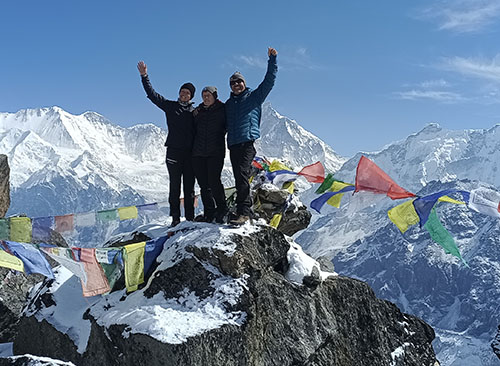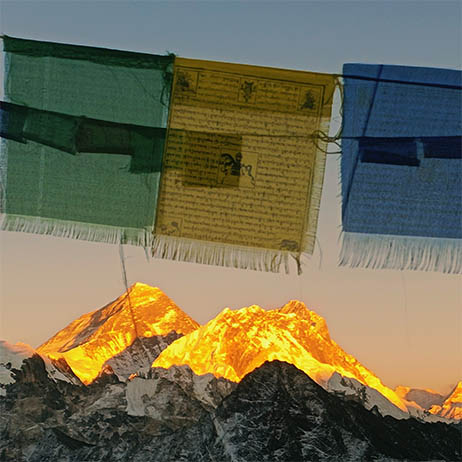If you’re an experienced trekker with cold-weather gear and preparation, the Best winter trekking in Nepal can be a wonderful adventure in the winter wonderland of the Himalayas. Such trekking offers a distinct and unique experience with the plus point of budget-friendly accommodation due to lower demand.
However, it’s important to emphasize proper preparation and have a positive attitude toward the challenges. If you’re willing to invest in proper cold-weather clothing and gear, then winter trekking can be suitable. If you prefer less crowded trails and are comfortable with the colder conditions, winter trekking might be appealing.
But, you must be personally fit, and comfortable for winter trekking. Otherwise, the winter landscape and atmosphere are just there to entertain adventurous spirits. Generally, winter trekking in higher altitudes isn’t recommended for inexperienced trekkers and beginners. If you cannot tolerate cold temperatures, winter trekking might not be suitable unless you are prepared to invest in high-quality cold-weather gear.
In addition to that, if you have health conditions aggravated by cold or altitude, it’s best not to take risks and therefore consult a medical professional before considering a winter trek.

Trekking in Nepal During the winter time.
What should you carry for your Winter Treks in Nepal?
Winter treks in Nepal can be significantly more challenging compared to trekking during other seasons due to extreme cold, snowy conditions, shorter daylight hours, and the potential for difficult terrain. Trails can be covered with ice and snow requiring careful footwork. Winter temperatures in higher sections can drop below freezing, increasing the risk of frostbite and hypothermia. Staying warm and properly insulated becomes a priority.
For the best winter treks in Nepal, being well-prepared for the cold, snowy, and potentially challenging conditions is essential. The Himalayan region can experience extreme weather conditions, so it’s essential to pack well for winter treks. The most important items to carry personally are listed below:
Clothing:
- Base Layers: Base Layers are the innermost clothing such as thermal tops and bottoms. They are the most crucial element of clothing for winter trekking as they keep you dry and warm. They provide insulation and prevent you from feeling cold due to sweat or moisture accumulation. As their alternatives, high-quality moisture-wicking synthetic fabrics or merino wool garments can be worn.
- Insulating Layers: These are mid-layer clothing items like fleece or down jackets. They trap body heat and prevent the outside cold. Thicker sweaters or multiple layers of clothing can serve as alternatives, but they may not provide the same level of warmth and weight efficiency.
- Trekking Pants: Trekking pants are insulated, water-resistant, and provide freedom of movement. Such a design gives a comfortable experience during trekking and acts as a protector against wind and moisture. You can wear a layer of regular hiking pants with thermal leggings, but they aren’t as effective as the trekking pants.
- Outer Shell: It consists of a waterproof and windproof jacket and pants. They are essential for protecting you from snow, rain, wind, and other external elements. The alternative for them is rainproof gears but the one mentioned earlier is best for extreme conditions.
- Gloves: Insulated and Waterproof gloves keep your hands warm and protect from cold and moisture. Gloves are essential for protecting fingers from frostbite. These winter gloves have better dexterity and protection than the mitten gloves.
- Hat: A warm beanie or hat is crucial as a significant amount of body heat is lost through the head. It helps keep you warm and prevents heat loss.
- Scarf or Neck Gaiter: A scarf or neck gaiter helps protect your neck and face from cold winds and potential frostbite. You can cover your nose and mouth and use them as a face mask against the cold winds.
- Socks: Woolen or thermal socks keep your feet warm and dry. Winter-specific socks are designed to manage moisture and warmth effectively.
Footwear:
You should always choose footwear and gear designed for the specific conditions of your trek especially when facing potentially harsh winter conditions in mountainous regions. One pair of hiking boots and gaiters are sufficient for a single trek.
- Hiking Boots: They are sturdy, supportive footwear designed to handle rugged terrain and provide stability for your feet and ankles. Hiking boots provide traction on slippery surfaces, reducing the risk of slips and falls. They provide ankle support reducing the risk of twisting or spraining your ankles. They keep your feet warm in cold temperatures with proper insulation. They come with waterproof membranes that keep your feet dry in wet and snowy conditions.
- Gaiters: They are protective coverings worn over hiking boots and lower legs. In winter trekking, their use is purposeful. They prevent snow, mud, rocks, and debris from entering your boots. They provide an extra layer of insulation around your ankles and lower legs. They can extend waterproofing for your boots by preventing water and snow from entering over the top of the boot.

Fresh Dip Snow During the Wintertime in Nepal
Importance of Hiking Boots and Gaiters:
Ordinary and regular shoes lack the traction needed for icy surfaces and don’t provide ankle support. They don’t have proper insulation and waterproofing which can lead to discomfort, frostbite, and potential health issues. Therefore, Hiking Boots and Gaiters are important during winter trekking. In their absence, you could face a range of issues such as the risk of falls, ankle injuries, and cold and wet feet.
Accessories:
While the agency provides some equipment and support, having your own personal gear ensures your comfort, safety, and satisfaction. The items that are crucial during winter trekking with an agency are listed below:
- Sunglasses: Sunglasses with UV and polarized filters are important to protect eyes from the sun’s reflection off the snow. Looking at such intense glare can snow-blind us, so sunglasses must be on our list.
- Headlamp or Flashlight: They are essential for navigating in low light conditions as daylight in winter is shorter. They may also be helpful while moving around in the dark.
- Trekking Poles: Trekking poles play a major role in providing stability and support in uneven terrain, and icy conditions. Using them also helps reduce strain on your knees.
- Backpack: Your backpack carries all your gear, clothing, food, and other essentials. It’s important to have a sturdy and properly fitting backpack to distribute the weight comfortably.
- Water Bottles: Insulated water bottles are necessary to prevent liquids from freezing. It’s necessary to remain hydrated during the trek.
- First Aid Kit: The first aid kit must include altitude sickness medication, pain relievers, and basic supplies for minor injuries.
- Personal Medications: If you have any specific medical needs or prescriptions, you should carry your personal medications for managing medical issues.
- Toiletries: Items like toothbrushes, toothpaste, and hand sanitizer, dry or wet wipes are necessary for your overall comfort and health.
Other Items:
- Portable Battery Charger
- Camera
- Local Cash
- Map and Compass/GPS
- Hand and Toe Warmer
- Books, Playing Cards, etc., for downtime
- Personal items like Sunscreen and Lip Balms
While these items are highly recommended for winter trekking due to their specific functions and benefits, there might be situations where you can improvise or do with alternatives. Consulting local guides, trekking companies, or experienced trekkers familiar with the region can provide valuable insights into the gear needed for your specific journey.
Conclusion:
One of the seasoned trekkers said, “Preparation is the key to conquering the frozen trails. A well-fitted down jacket, insulated boots, and a strong cardiovascular foundation are your best friends.”
Proper preparation and fitness are essential for winter trekking in Nepal due to the unique challenges posed by cold temperatures, snow-covered trails, and higher altitudes. It is important to be physically prepared and mentally resilient while embarking on a winter trek in Nepal. The cold and snowy conditions demand a higher level of fitness and proper gear to fully appreciate the beauty of the winter wonderland while being safe and comfortable.







